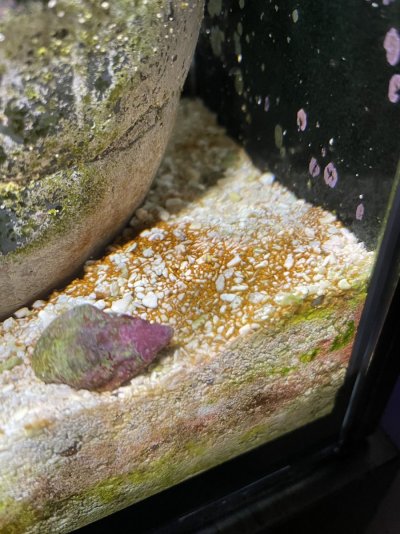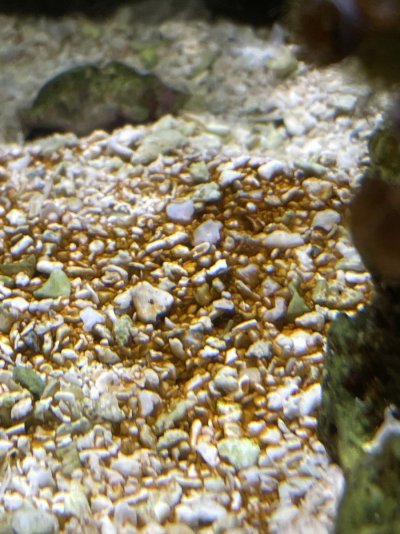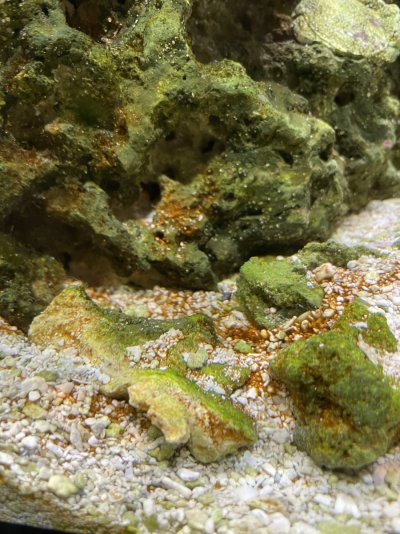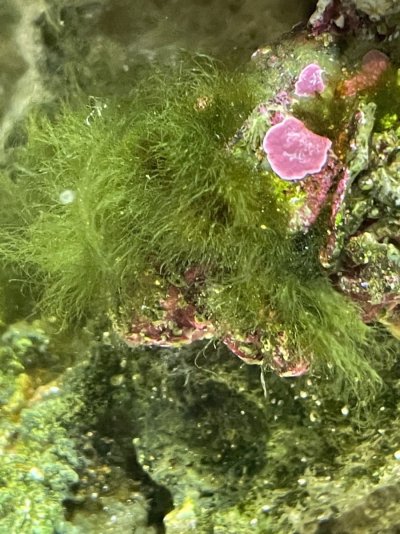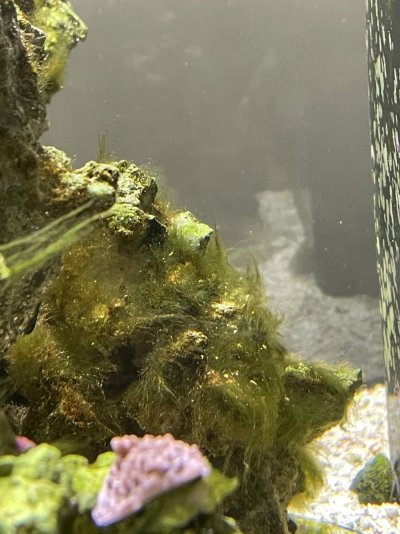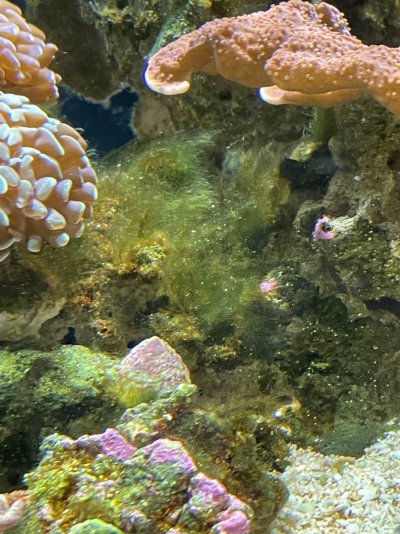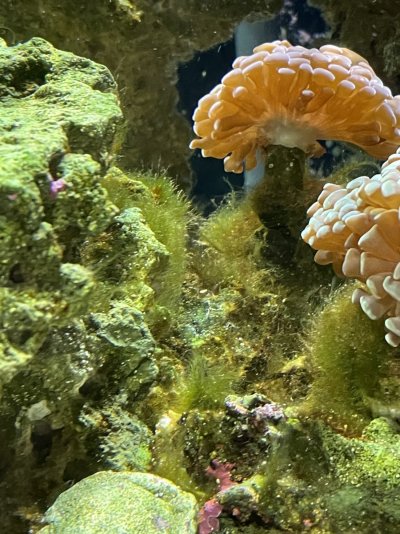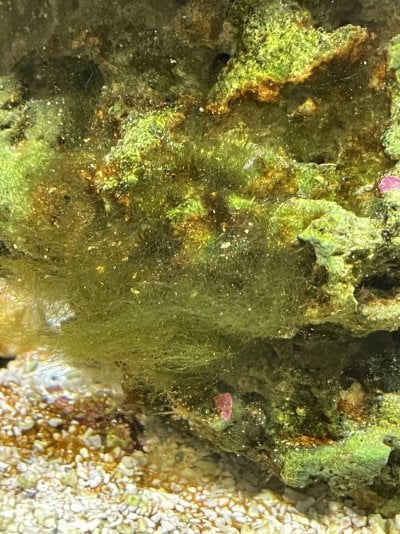Hi folks...
I could really use some help. I feel like every step forward is two steps back with my battle against hair algae and I'm in need of some advice.
Some background:
my tank is 50 gallon display with a small sump and is about one year old now. The tank was started with dry base rock and live sand. I've been struggling with hair algae for some months now. Back in Feb, I dosed vibrant for a few weeks and most of it went away however what replaced it was a nasty rusty brown cyano (I think?) outbreak. Fast forward to today and now everything is covered in brown especially the substrate, some on the rocks, and some on the back wall. The hair algae is coming back with a vengeance. There are spots on the rock with hair algae that also have quite a bit of brown cyano(?) inside of the hair algae.
I've been running UV at night - just a Green Killing Machine.
Things Ive been dosing for the algae:
I've been dosing 3% hydrogen peroxide at night (1ml per 10 gals). I am also dosing microbacter7 and microbacter clean every morning. (usually 2 caps of MC and 1 cap of M7) I skip a couple of days here and there with the dosing just because I'm really afraid of over doing it. I've also been making my own phytoplankton and dosing about 30 ml a day hoping to out compete some of this. (I went out of town for a few days recently and didn't dose anything, just had someone feed for me, and the algae was a lot worse when I got home)
I have beefed up my clean up crew.
Currently in my fifty gallon tank I have:
4 Trochus snails, 8 atraea snails, 12 nassarius snails, 7 cerith snails, 1 emerald crab, 1 brittle star, 5 golf ball sized mexican turbo snails, 8 blue leg hermits, 2 yellow tip hermits, 2 scarlet reef hermits, 2 orange and black hermits, 1 tuxedo urchin, and one pistol shrimp
Livestock is:
2 clowns, 1 melanurus wrasse, 1 yellow watchman goby, 1 black spot fox face
I use a 5 stage liquagen RODI to filter my water and use Reef Crystals salt. I've been experimenting with more or less water changes to see what works but I'm changing 10 gallons every three weeks currently.
lighting:
I'm running a Radion XR15 at 68% schedule intensity using the RMS mount. I'm using Coralab's AB+ spectrum. The lights run from 11am to 10pm. Full lights are on for 7 and a half hours with the rest being sun set and sun rise on either side of that.
I've been using phosguard in a mesh bag in my filter sock. I use 6 tablespoons and usually leave it in for about a week (Maybe I should use more or swap it out more frequently?)
I run a refugium with Chaeto. No problems growing the chaeto at all. I run my fuge lights for 14 and a half hours which seems to be the sweet spot for my tank to keep nitrates stable at around 5.
Feeding (and I think this might be the issue... I don't know how much to feed)
I feed about a cube of frozen a day and leave a small strip of nori in the tank for the foxface every day.
If I feed them pellets instead it's usually two or three pinches.
I feed the corals twice a week
I feed: fuel (1/2 cap), reefroids (1/4 teaspoon), and coral frenzy pellets (a pinch or two) for the LPSs
My parameters as of yesterday are:
Sal - 1.026
Nitrate - 4
Phos - 0.1
Cal - 465
Mag 1500
Alk - 9
PH - 8.2
Temp - 78
If I don't get in there and turkey baste it, by 1pm today the substrate will be covered in rusty brown again and the hair algae keeps swaying in the flow taunting me!
I'm doing a 10g water change later today and will hopefully pull the rocks that I can get out to scrub the hair algae off.
Any other ideas? Should I probably feed less? More phosguard?
I really want to beat this! Any advice would be appreciated.
I could really use some help. I feel like every step forward is two steps back with my battle against hair algae and I'm in need of some advice.
Some background:
my tank is 50 gallon display with a small sump and is about one year old now. The tank was started with dry base rock and live sand. I've been struggling with hair algae for some months now. Back in Feb, I dosed vibrant for a few weeks and most of it went away however what replaced it was a nasty rusty brown cyano (I think?) outbreak. Fast forward to today and now everything is covered in brown especially the substrate, some on the rocks, and some on the back wall. The hair algae is coming back with a vengeance. There are spots on the rock with hair algae that also have quite a bit of brown cyano(?) inside of the hair algae.
I've been running UV at night - just a Green Killing Machine.
Things Ive been dosing for the algae:
I've been dosing 3% hydrogen peroxide at night (1ml per 10 gals). I am also dosing microbacter7 and microbacter clean every morning. (usually 2 caps of MC and 1 cap of M7) I skip a couple of days here and there with the dosing just because I'm really afraid of over doing it. I've also been making my own phytoplankton and dosing about 30 ml a day hoping to out compete some of this. (I went out of town for a few days recently and didn't dose anything, just had someone feed for me, and the algae was a lot worse when I got home)
I have beefed up my clean up crew.
Currently in my fifty gallon tank I have:
4 Trochus snails, 8 atraea snails, 12 nassarius snails, 7 cerith snails, 1 emerald crab, 1 brittle star, 5 golf ball sized mexican turbo snails, 8 blue leg hermits, 2 yellow tip hermits, 2 scarlet reef hermits, 2 orange and black hermits, 1 tuxedo urchin, and one pistol shrimp
Livestock is:
2 clowns, 1 melanurus wrasse, 1 yellow watchman goby, 1 black spot fox face
I use a 5 stage liquagen RODI to filter my water and use Reef Crystals salt. I've been experimenting with more or less water changes to see what works but I'm changing 10 gallons every three weeks currently.
lighting:
I'm running a Radion XR15 at 68% schedule intensity using the RMS mount. I'm using Coralab's AB+ spectrum. The lights run from 11am to 10pm. Full lights are on for 7 and a half hours with the rest being sun set and sun rise on either side of that.
I've been using phosguard in a mesh bag in my filter sock. I use 6 tablespoons and usually leave it in for about a week (Maybe I should use more or swap it out more frequently?)
I run a refugium with Chaeto. No problems growing the chaeto at all. I run my fuge lights for 14 and a half hours which seems to be the sweet spot for my tank to keep nitrates stable at around 5.
Feeding (and I think this might be the issue... I don't know how much to feed)
I feed about a cube of frozen a day and leave a small strip of nori in the tank for the foxface every day.
If I feed them pellets instead it's usually two or three pinches.
I feed the corals twice a week
I feed: fuel (1/2 cap), reefroids (1/4 teaspoon), and coral frenzy pellets (a pinch or two) for the LPSs
My parameters as of yesterday are:
Sal - 1.026
Nitrate - 4
Phos - 0.1
Cal - 465
Mag 1500
Alk - 9
PH - 8.2
Temp - 78
If I don't get in there and turkey baste it, by 1pm today the substrate will be covered in rusty brown again and the hair algae keeps swaying in the flow taunting me!
I'm doing a 10g water change later today and will hopefully pull the rocks that I can get out to scrub the hair algae off.
Any other ideas? Should I probably feed less? More phosguard?
I really want to beat this! Any advice would be appreciated.





